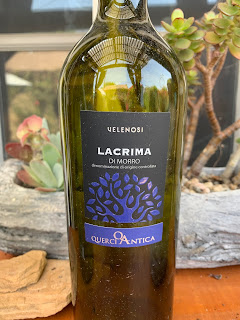One of the lesser-known wine regions of Italy is called Marches, or Le Marche in Italian. Not a super-well-known region outside of Italy to most people, it is nonetheless home to one of my favorite Italian white wines called Verdicchio. To my delight, more and more people are appreciating these sea-influenced, crisp and minerally whites, which are thirst-quenching summer wines. The Marche region makes other wines that are also worth exploring, including reds based on Montepulciano and Sangiovese, the main grapes in the neighboring and better-known regions of Tuscany and Abruzzo.
During the 2020 virtual Wine Media Conference in August, Velenosi, one of Le Marche's prominent producers, hosted a virtual tasting, providing four of their wines to attendees to try at home. The session was hosted by Lora Donadoni, aka The Italian Wine Girl.
Before we go into Velonosi's lovely wines, let's take a closer look at Le Marche, the wine region.
Le Marche: Between the Mountains and the Sea
The Marche region stretches along the Adriatic coast of eastern Italy, and borders Umbria and Tuscany to the west, Emilia Romagna to the north, and Lazio and Abruzzo to the south. While the region touches on so many other regions, it has a distinct quality of its own based on its proximity to the sea and the mountains, as well as its soils and topography. The region features 15 DOCs and three DOCGs. The largest and most productive DOC is that of Verdicchio de Castelli di Jesi.
Marche's location in Italy (see map) is part of the reason it has not became as well known as regions like Tuscany and Venezio, as it is off the main transport spine going up and down Italy. While the north has Venice and the south has Rome, there are no world-renowned cities in Le Marche.It's even hard to gather an abundance of information on Mache as a wine region -- several of my trusted sources do not even have entries for this region. For example, The Wine Bible skips right over Marche, listing only Verdicchio Bianco as "simple clean white wines in the region known as Marche." Similarly, World Atlas of Wine has no entry for Marche, just a small sub-section in the "Central Italy" chapter that mentioned Verdicchio and the "reds of Marche [based on the Montepulciano and Sangivoese grapes that] have been slower to carve out their identity."
Marche offers wine and so much more. While I have never personally been there, the presentation provided by Velenosi plus Internet research on Marche have whetted my appetite for a post-pandemic visit!
Marche has miles of pristine beaches with world-class resorts and seafood restaurants, historic medieval towns, Romanesque churches, natural preserves and festivities such as the Quintana Palio Joust (a medieval horse racing event). The joust takes place in the beautiful town of Ascoli Piceno, which is 12 miles inland from the Adriatic and in the southern portion of Marche, close to Abruzzo.
Ascoli Piceno, Home of Velenosi
Ascoli Piceno is the home base of Velenosi, a "self-made winery," per the winery's literature, started in 1984 by Ercole and Angela Velenosi, with little capital or know-how. While they may not be one of the old families of the Italian wine world, today they produce 2.5 million bottles on about 360 acres of vines in Marche, plus an additional 40 acres in Abruzzo.
Velenosi's Ascoli Piceno vines are located on the fertile clay soils in the hills surrounding the Tronto river valley, where the Mediterranean climate provides warm, dry summers and mild, wet winters.
Velenosi produces a large variety of bottlings, ranging from sparklings to whites, roses, reds and even dessert/sweet wines, as well as Bag in Box wines and olive oils.
The sparklings are made from Chardonnay, Pinot Nero and the lesser-known Passerina, in Charmat and Traditional method. Still whites include Verdicchio, Pecorino, Chardonnay, Pecorino-Trebbiano blends known as Falerio Bianco, and Passerina. The Rose, or Rosata, is produced from the Montepulciano grape. Reds include Lacrima di Morro d'Alba, a specialty of the Marche, and the Rosso Piceno blends of Montepulciano and Sangiovese. Sweet wines are made with Moscato, Lacrima and Sciroppe di Visciole.
The WMC Tasting
 2019 Querciantica Verdicchio Dei Castelli Di Jesi DOC Classico
2019 Querciantica Verdicchio Dei Castelli Di Jesi DOC Classico

The wine is 100% Verdicchio, and is grown in the hills of Castelli di Jesi's oldest areas.
This wine really hit the spot on the warm summer night of the tasting. As one fellow WMC attendee stated, it cut right through the humidity.
Fermented at low temperature, this lovely, feminine white delights the palate with apples, stone fruit, and flowers, and just a slight vegetal note. It was chock full of minerals owing to the clay and limestone soils, with a distinct salinity that, in my mind, tasted of the Adriatic Sea.
Per Donadoni, this wine can age, and pairs well with oysters, crudite, shell fish, and risotto.
The wine retails for $15 to $20.


















